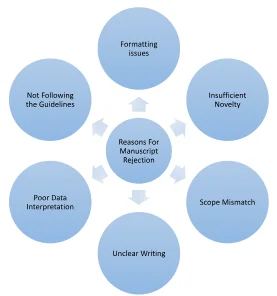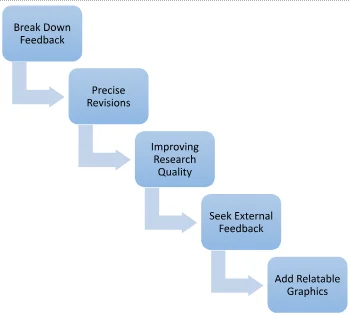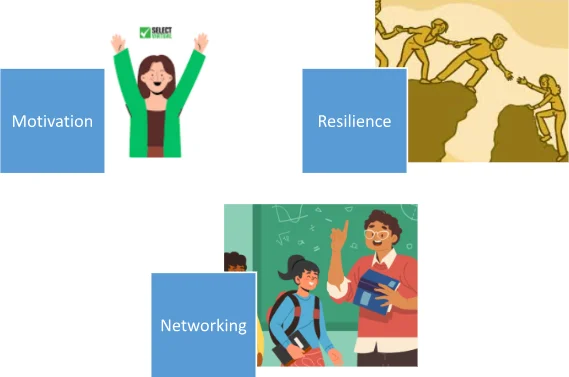Overcoming Manuscript Rejection: Strategies for Revision and Resubmission

The journey of publication is not easy and comes with many challenges, and manuscript rejection is one of the main obstacles students, as well as professionals, sometimes face. Instead of viewing rejection as a failure, try to find it as an opportunity, and as a chance to refine your work.
Knowing that manuscript rejection is common for researchers, we will examine some strategies that can help researchers overcome it. In this post, let’s dig into those revision and resubmission strategies you need to know to overcome this obstacle.
Common Reasons for Manuscript Rejection
Before digging into the strategies first, we must know the common reasons for manuscript rejection. Understanding these reasons can help authors avoid them in future submissions. Some of the main reasons are:
Formatting Issues
Not following the journal’s particular formatting requirements is one of the simplest grounds for rejection. This covers problems with figure formats and the general organization of the document. Journals frequently have stringent policies, and breaking them might lead to rejection right away. Before submitting, authors should carefully examine these guidelines.
Not Following Journal Guidelines
Every publication has different guidelines for submissions. Your manuscript may be rejected right away if it doesn’t match these. These rules include everything, including word counts and formatting preferences. To make sure your work is appropriate for publishing in that forum, it is essential to investigate the journal’s scope.
Insufficient Novelty
The study may be rejected if it lacks originality or makes no substantial contribution to the body of current literature. Reviewers seek out studies that contribute to the field’s understanding. Clearly stating how your work closes the gaps and provides fresh perspectives is crucial.
Poor Data Interpretation
While a lack of data might provide ambiguous findings, a misunderstanding can have unambiguous conclusions. Data-appropriate statistical analysis should be performed, and the results should validate the conclusions reached.
Unclear Writing
Uncertain goals and ambiguous language might irritate reviewers and result in rejection. Effective communication of your ideas will be facilitated by a manuscript that is well-structured, has distinct titles, and makes sense.
Mismatch the Journal’s Scope
One of the most frequent mistakes that can result in instant rejection is submitting to a publication that is unrelated to your study topic or target audience. Make sure your work aligns with the readership and focus of possible publications by doing a good set of research.

Initial Steps After Receiving a Rejection
Receiving a rejection letter can be really disheartening, but don’t worry it’s an opportunity to refine your work. Constructive steps can be taken after receiving a rejection of the manuscript.
Read the Decision Letter
Spend some time trying to figure out why you were rejected. The decision letter frequently includes insightful criticism. Both the main ideas and the more specific criticism should be taken into consideration because they offer suggestions on how to make your work better.
Differentiate between Rejection, Revision & Submit
Revisions and resubmissions are permitted for some rejections. Knowing the difference will help you decide what to do next. If the letter says that changes are welcome, take advantage of the chance to improve your work in light of the reviewers’ comments.
Reflect before React
Steer clear of automatic responses. Take a day or two to gather your thoughts before reading the comments again. Because emotional reactions can impair judgment, giving yourself time to think can result in more fruitful adjustments.
Know the Type Of Rejection
Your revising strategy may change if you are aware of whether the rejection was desk or peer-reviewed. Peer-reviewed rejections contain reviewer input, which can be more thorough and helpful than desk rejections, which are frequently based on editorial judgments of fit.
Responding to Reviewer Comments Professionally
Take criticism well. Recognize good qualities and politely dispute any unjust criticism. You will benefit greatly from maintaining this professional manner in subsequent submissions.
Create a Summarized Document
This technique not only makes your editing process more organized but also shows editors that you are dedicated to getting better. Reviewers may see how you responded to each criticism in a well-organized response document.
Effective Strategies for Manuscript Revision
Revision is necessary for successful publication, and incorporating thoughtful feedback into the work can enhance its quality, making it more compelling and interesting to read.
Break Down the Feedback
Sort comments into two categories, important and small. This aids in setting priorities for what should be taken care of initially. While small fixes might comprise formatting changes or grammatical improvements, major faults could include basic flaws in technique.
Make Precise Revisions
Concentrate on improving your research’s validity, logic, and clarity. Make sure you have solid evidence to back up your claims. The goal of every revision should be to strengthen and improve the coherence of your text.
Improving Research Clarity and Structure
To increase the effect, polish the introduction and abstract. A crisp abstract encapsulates the importance of your study, while an engaging introduction sets the scene. Make sure each part flows logically and coherently so that readers can readily follow the way you are taking them into the story.
Seek External Feedback
Before resubmitting, you might improve your paper and get fresh perspectives by soliciting feedback from peers or mentors. New viewpoints might point up places you may have missed for improvement.
Add Relatable Graphs & Tables
Citations and visual components should successfully bolster your claims. Make sure that figures and tables are properly cited in the text and have clear labels. Maintaining professionalism also requires using consistent citation styles.

How to Resubmit a Revised Manuscript with Confidence
A revised document must be carefully prepared before being resubmitted. You may successfully present your enhanced work and greatly increase your chances of acceptance by selecting the appropriate publication and writing a compelling submission.
Choosing the Right Journal for Resubmission
Read the original journal readership and scope again. If applicable, think about submitting to journals that have a comparable topic or a lesser impact factor. Seek out publications with related papers that fit the subjects of your research.
Creating a Cover Letter
Indicate in detail the modifications made in response to reviewer feedback in your cover letter. Highlight the positive aspects of your research and its advancements. A cover letter that is well-written will help your resubmission go more smoothly.
Provide a Detailed Response
It may be quite powerful to address each remark in detail, demonstrating your approach to each one. In your comments, show that you are committed to improving your work in light of criticism by being polite and helpful.
Follow the Formatting Guidelines
Make sure to tailor your submission according to the new journal format, as every journal has different requirements. Your focus on every small thing will highlight your professionalism and dedication to your work. Ensure that all elements from the title page to referencing are up to the point and you don’t miss anything. These small things will enhance the credibility of your manuscript, as not only is the readability factor that matters for a good manuscript but this small formatting guideline also holds a significant position.
Coping Techniques to Do Well After Rejection
Although rejection is an unavoidable part of the academic process, how you cope with it is the art of your intelligence. The coping mechanisms of every person may differ, but these are some essential techniques to help you stay resilient and motivated, even after your manuscript is rejected:
Maintaining Motivation After Rejection
Maintaining motivation following a rejection is really difficult but it is what all matters. If you lose all hope and set you will gain nothing. A good method to do this is to acknowledge the mistakes and find a way to solve them. Recognize accomplishments like finishing a draft revision or getting encouraging comments from colleagues. Progress, no matter how small, may be acknowledged, and this can greatly increase drive.
Developing Resilience
Overcoming setbacks requires building resilience. Develop a development mentality by seeing obstacles as chances to gain knowledge. This kind of thinking might give you the flexibility to deal with rejection in the future. With the knowledge you’ve gathered from earlier experiences, resilience enables you to recover stronger.
Looking for Assistance
When you are rejected, don’t be afraid to ask for help. Talking to your parents, fellows, and teachers is the best way to stay on track and not get disheartened. Sharing your experiences might reassure you that you’re not traveling this path alone, and it will help you a lot. You may also have a good attitude about your academic pursuits by getting encouragement from others. Additionally, considering manuscript writing services can provide valuable assistance and support to help you succeed.

Conclusion:
It is normal for manuscripts to be rejected during the academic publication process. Consider it a chance to get better in your research and writing, rather than a failure. Keeping a good outlook and selecting the appropriate diary is equally important. If you persevere, every rejection will bring you one step closer to success. You may turn rejection into a useful tool for your academic and professional progress if you have the correct techniques and a growth-oriented mindset.






